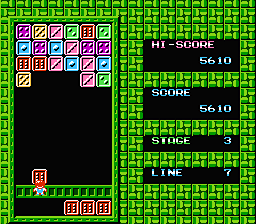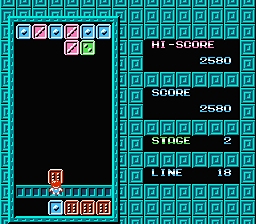
Palamedes (1990-)
Developer: Taito | Natsume
Publisher: Hot-B
Genre: Puzzle
Palamedes for the NES was developed by Taito and released in 1990, with Hot-B serving as its publisher for the home console version. The game is a puzzle action title, originally created as an arcade game before being adapted for the NES. It combines elements of dice-matching mechanics with reflex-based gameplay, offering a distinct challenge compared to traditional puzzle games of the era. There were no prequels for the NES, and the home version was the primary console adaptation, though the arcade original influenced later puzzle titles within Taito’s portfolio.
In the game, players control a character who throws dice at a descending stack of enemy dice, attempting to match numbers to clear them from the screen. The objective is to prevent the stack from reaching the bottom while maintaining a strategic pace in throwing dice and creating chains. Its design draws inspiration from classic puzzle games like Tetris, emphasizing pattern recognition and quick thinking, but introduces a numerical element that adds complexity and strategic depth.
Gameplay combines fast-paced action with mental calculation, requiring players to match numbers on the descending dice to eliminate them. Special dice with unique properties occasionally appear, providing opportunities to clear multiple layers or manipulate the stack. Levels gradually increase in speed and complexity, with different arrangements and dice colors requiring careful attention. The game’s mechanics reward precision, timing, and pattern recognition, making each stage progressively more challenging.
The soundtrack features upbeat and rhythmic compositions that complement the intensity of the puzzle gameplay, while sound effects provide clear feedback for successful matches, dice throws, and level completion. Palamedes did not receive direct sequels on the NES, though it remained influential among Taito’s later puzzle games. Promotion relied on print advertisements and coverage in gaming magazines, highlighting its addictive gameplay and arcade origins. Reception was generally positive, with critics praising its unique mechanics and fast-paced challenge, though some noted that its difficulty curve could be steep for casual players.
Images from MobyGames
Buy Palamedes
Click one of the Ebay or Amazon buttons below to check the latest prices and purchase Palamedes for the Nintendo Entertainment System.

Related Searches
Palamedes NES Download
Palamedes is available to purchase and download from a range of vendors. Always shop around...
Palamedes NES Manual
Various repositories around the internet have scanned and archived a range of retro manuals. Search now to.....
Palamedes NES Rom
We don't host or link to rom sites for this game. However, there are many sites out there that may be...
Palamedes NES Walkthrough
Many sites - particularly YouTube - host a range of walkthrough videos to guide you in your quest to get...
Palamedes NES Cheats
There are various sites out there that can offer cheat codes for games. Search now to find all available...
Palamedes NES Controls
This information can often be obtained through the user manual. Alternatively there are many sites out there...
Palamedes NES Release Date
The initial release date for Palamedes is stated as November 1990. Other ports of the game may..
Palamedes NES Review
There are many sites out there that have collated and documented historic reviews of this game. Search now...
Palamedes Famicom
As a Nintendo Entertainment System release, this game was also likely also available on the Famicom. This....
Palamedes NES Speedrun
There is now a community of competitive speedrunners who will try and gain the fastest possible time on their....








